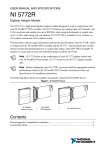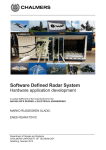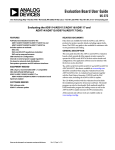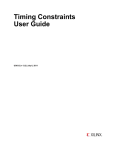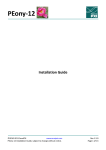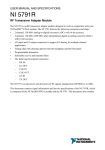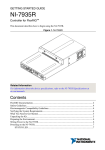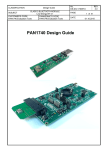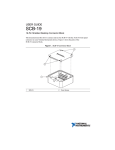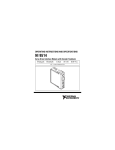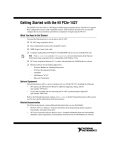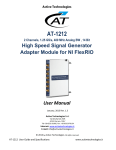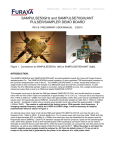Download NI 5782R User Manual and Specifications
Transcript
NI 5782R User Manual and Specifications The NI 5782 is an analog dual-input, dual-ouput, intermediate-frequency (IF) transceiver adapter module designed to work with your NI FlexRIO™ FPGA module. The NI 5782 features two analog input (AI) channels with 14-bit sample rates of up to 250 MS/s. The NI 5782 also has two analog output (AO) channels with 16-bit sample rates of up to 500 MS/s when using both AO channels, or up to 1 GS/s when using only one AO channel. This document contains signal information and specifications for the NI 5782R, which is composed of an NI FlexRIO FPGA module and the NI 5782 adapter module. This document also contains tutorial sections that demonstrate how to acquire data using a LabVIEW FPGA example VI and how to create and run your own LabVIEW project with the NI 5782R. Note NI 5782R refers to the combination of your NI 5782 adapter module and your NI FlexRIO FPGA module. NI 5782 refers to your NI 5782 adapter module only. Caution The protection provided by the NI 5782R can be impaired if it is used in a manner not described in this document. Contents Electromagnetic Compatibility Guidelines .............................................................................. 2 How to Use Your NI FlexRIO Documentation Set .................................................................. 3 Front Panel and Connector Pinouts .......................................................................................... 4 Block Diagram.......................................................................................................................... 7 NI 5782 Component-Level Intellectual Property (CLIP)......................................................... 8 Connecting Cables .................................................................................................................... 10 Clocking.................................................................................................................................... 10 Using Your NI 5782R with a LabVIEW FPGA Example VI .................................................. 11 Creating a LabVIEW Project and Running a VI on an FPGA Target...................................... 13 Appendix A: Specifications...................................................................................................... 16 Appendix B: Installing EMI Controls ...................................................................................... 34 Where to Go for Support .......................................................................................................... 36 Figure 1. NI FlexRIO Device NI FlexRIO Adapter Module + NI FlexRIO FPGA Module = NI FlexRIO Device Before configuring your NI 5782R, you must install the appropriate software and hardware. Refer to the NI FlexRIO FPGA Module Installation Guide and Specifications for installation instructions. Figure 1 shows an example of a properly connected NI FlexRIO device. Note Electromagnetic Compatibility Guidelines This product was tested and complies with the regulatory requirements and limits for electromagnetic compatibility (EMC) as stated in the product specifications. These requirements and limits are designed to provide reasonable protection against harmful interference when the product is operated in its intended operational electromagnetic environment. This product is intended for use in industrial locations. There is no guarantee that harmful interference will not occur in a particular installation, when the product is connected to a test object, or if the product is used in residential areas. To minimize the potential for the product to cause interference to radio and television reception or to experience unacceptable performance degradation, install and use this product in strict accordance with instructions in the product documentation. Furthermore, any changes or modifications to the product not expressly approved by National Instruments could void your authority to operate it under your local regulatory rules. To ensure the specified EMC performance, you must install PXI EMC Filler Panels (National Instruments part number 778700-01) in adjacent chassis slots. For more information about installing PXI EMC filler panels in your system, refer to the Appendix B: Installing EMI Controls section of this document. Caution To ensure the specified EMC performance, operate this product only with shielded cables and accessories. Caution This product is sensitive to electrostatic discharge (ESD). To ensure the specified EMC performance, follow the programming instructions listed at the end of the Using Your NI 5782R with a LabVIEW FPGA Example VI and Creating a LabVIEW Project and Running a VI on an FPGA Target sections of this document. Caution 2 | ni.com | NI 5782R User Manual and Specifications Caution To ensure the specified EMC performance, the length of all I/O cables must be no longer than 30 m (100 ft). How to Use Your NI FlexRIO Documentation Set Refer to Figure 2 and Table 1 for information about how to use your NI FlexRIO documentation set. Figure 2. How to Use Your NI FlexRIO Documentation Set INSTALL Hardware and Software NI FlexRIO FPGA Module Installation Guide and Specifications CONNECT Signals and Learn About Your Adapter Module NI FlexRIO Adapter Module User Guide and Specifications PROGRAM Your NI FlexRIO System in LabVIEW FPGA Module Are You New to LabVIEW FPGA Module? LEARN About LabVIEW FPGA Module Yes No No LabVIEW FPGA Module Help NI FlexRIO Help NI 5782R User Manual and Specifications LabVIEW Examples | © National Instruments | 3 Table 1. NI FlexRIO Documentation Locations and Descriptions Document Location Description NI FlexRIO FPGA Module Installation Guide and Specifications Available in your FPGA module hardware kit, from the Start Menu, and at ni.com/ manuals. Contains installation instructions for your NI FlexRIO system and specifications for your FPGA module. NI 5782R User Manual and Specifications (this document) Available from the Start Menu and at ni.com/manuals. Contains signal information, examples, CLIP details, and specifications for your adapter module. LabVIEW FPGA Module Help Embedded in LabVIEW Help and at ni.com/manuals. Contains information about the basic functionality of the LabVIEW FPGA module. NI FlexRIO Help Available from the Start menu and at ni.com/manuals. Contains FPGA module, adapter module, and CLIP configuration information. LabVIEW Examples Available in NI Example Finder. Contains examples of how to run FPGA VIs and Host VIs on your device. IPNet ni.com/ipnet Contains LabVIEW FPGA functions and intellectual property to share. NI FlexRIO product page ni.com/flexrio Contains product information and data sheets for NI FlexRIO devices. Front Panel and Connector Pinouts Table 2 shows the front panel connector and signal descriptions for the NI 5782. Refer to Appendix A: Specifications for additional signal information. To avoid permanent damage to the NI 5782, disconnect all signals connected to the NI 5782 before powering down the module, and connect signals only after the adapter module has been powered on by the NI FlexRIO FPGA module. Caution Connections that exceed any of the maximum ratings of any connector on the NI 5782R can damage the device and the chassis. NI is not liable for any damage resulting from such signal connections. For the maximum input and output ratings for each signal, refer to Appendix A: Specifications. Caution 4 | ni.com | NI 5782R User Manual and Specifications Table 2. NI 5782 Front Panel Connectors Device Front Panel NI 5782 Connector AUX I/O Refer to Table 3 for the signal list and descriptions. CLK IN 50 Ω single-ended (SE) external Reference or Sample Clock input. TRIG Trigger input channel. AI 0 50 Ω SE analog input (AI) channel 0. AI 1 50 Ω SE AI channel 1. AO 0 50 Ω SE analog output (AO) channel 0. AO 1 50 Ω SE AO channel 1. AUX I/O CLK IN TRIG Signal Description AI 0 AI 1 AO 0 AO 1 14-Bit AI 16-Bit AO Analog I/O NI 5782R User Manual and Specifications | © National Instruments | 5 AUX I/O Connector Table 3. NI 5782 AUX I/O Connector Pin Assignments AUX I/O Connector Pin Signal 1 DIO Port 0 (Bit 0) 2 GND 3 DIO Port 0 (Bit 1) Bidirectional SE DIO data channel. 4 DIO Port 0 (Bit 2) Bidirectional SE DIO data channel. 5 GND 6 DIO Port 0 (Bit 3) Bidirectional SE DIO data channel. 7 DIO Port 1 (Bit 0) Bidirectional SE DIO data channel. 13 8 GND 11 9 DIO Port 1 (Bit 1) Bidirectional SE DIO data channel. 10 DIO Port 1 (Bit 2) Bidirectional SE DIO data channel. 5 11 GND 3 12 DIO Port 1 (Bit 3) Bidirectional SE DIO data channel. 1 13 PFI 0 Bidirectional SE DIO data channel. 14 NC 15 PFI 1 Bidirectional SE DIO data channel. 16 PFI 2 Bidirectional SE DIO data channel. 17 GND Ground reference for signals. 18 +5V +5 V power (10 mA maximum). 19 PFI 3 Bidirectional SE DIO data channel. 19 18 17 16 15 14 12 10 9 8 7 6 4 2 Signal Description Bidirectional single-ended (SE) digital I/O (DIO) data channel. Ground reference for signals. Ground reference for signals. Ground reference for signals. Ground reference for signals. No connect. The AUX I/O connector accepts a standard, third-party HDMI cable, but the AUX I/O port is not an HDMI interface. Do not connect the AUX I/O port on the NI 5782 into the HDMI port of another device. NI is not liable for any damage resulting from such signal connections. Caution 6 | ni.com | NI 5782R User Manual and Specifications Block Diagram Figure 3 shows the NI 5782 block diagram and signal flow to and from the NI 5782 component-level intellectual property (CLIP) by way of the adapter module and the corresponding NI 5782 Multiple Sample CLIP in LabVIEW FPGA. Figure 3. NI 5782 Connector Signals and NI 5782 CLIP Signal Block Diagram NI 5782 Adapter Module LabVIEW FPGA CLIP 8 8 Bus Transceiver AUX I/O 4 4 2 4 DIO Port 0 Rd Data <0..3>, DIO Port 1 Rd Data <0..3> DIO Port 0 Wr Data <0..3>, DIO Port 1 Wr Data <0..3> PFI <0..3> Rd Data PFI <0..3> Wr Data DIO Port <0..1> Write Enable PFI <0..3> Write Enable Trigger Input Internal Reference Clock CLK IN Switch Switch Clock Buffer AD9512 ADCs DACs Switches Analog front end (FE) Clock Synthesizer TRIG Bus Translator Switch AD9512 AI 0 Sample Clock Data Clock Analog Front End ADC AI 1 Analog Front End AO 0 Analog Front End AI 0 Data N Data Clock AI 0 Data N–1 ADC Interface AI 1 Data N AI 1 Data N–1 DAC AO 1 SPI Read SPI Write SPI Address SPI Write Data SPI Read Data SPI Device Select SPI Idle Initialization Done Reinitialize Configuration Error Sample Clock Select Sample Clock Commit Synthesizer Locked SPI Engine Interfacing with: Data Clock AO 0 Data N AO 0 Data N–1 AO 0 Data N–2 AO 0 Data N–3 AO 1 Data N AO 1 Data N–1 AO 1 Data N–2 AO 1 Data N–3 DAC Interface Analog Front End IOModSyncClock NI 5782R User Manual and Specifications | © National Instruments | 7 NI 5782 Component-Level Intellectual Property (CLIP) The LabVIEW FPGA Module includes component-level intellectual property (CLIP) for HDL IP integration. NI FlexRIO devices support two types of CLIP: user-defined and socketed. • User-defined CLIP allows you to insert HDL IP into an FPGA target, enabling VHDL code to communicate directly with an FPGA VI. • Socketed CLIP provides the same IP integration functionality of the user-defined CLIP, but also allows the CLIP to communicate directly with circuitry external to the FPGA. Adapter module socketed CLIP allows your IP to communicate directly with both the FPGA VI and the external adapter module connector interface. The following figure shows the relationship between an FPGA VI and CLIP. Figure 4. CLIP and FPGA VI Relationship NI FlexRIO FPGA Module FPGA Adapter Module CLIP Socket LabVIEW FPGA VI User-Defined CLIP 8 | ni.com | Socketed CLIP Socketed CLIP Socketed CLIP Fixed I/O DRAM 1 CLIP Socket Fixed I/O DRAM 0 CLIP Socket DRAM0 DRAM1 NI 5782R User Manual and Specifications Fixed I/O Adapter Module External I/O Connector User-Defined CLIP The NI 5782 ships with socketed CLIP items that add module I/O to the LabVIEW project. The NI 5782 ships with the following CLIP items: 1. NI 5782 Multiple Sample CLIP—The analog input channels generate two samples per clock cycle at a clock rate that is half the sample rate. The analog output channels generate four samples per clock cycle at a clock rate that is one quarter of the sample rate. The AI default sample rate is 250 MHz, and the AO default sample rate is 500 MHz. The default clock rate for this CLIP is 125 MHz. You can set a lower sample rate by using an external Sample Clock. This CLIP presents the data to the diagram in a decelerated format. The ADC data lands at half the rate as the ADC clock. The DAC data must be presented in four time samples per clock on each channel. This CLIP provides access to two AI channels, two AO channels, eight bidirectional DIO channels, four bidirectional PFI channels, and an input clock selector that can be configured to use one of the following settings: – Internal Sample Clock – Internal Sample Clock locked to an external Reference Clock through the CLK IN connector – External Sample Clock through the CLK IN connector – Internal Sample Clock locked to an external Reference Clock through IoModSyncClock – External Sample Clock through IoModSyncClock This CLIP also contains an engine to program the CLK chip, ADCs, and DACs, either through predetermined settings for an easier instrument setup, or through a raw SPI address and data signals for a more advanced setup. The NI 5782 Multiple Sample CLIP is the default CLIP. 2. NI 5782 Single Sample CLIP—The analog input channels generate one sample per clock cycle and the analog output channels generate two samples per clock cycle. The default clock rate for the Multiple Sample CLIP is 250 MHz. The Sample Clock rates of AI (250 MHz) and AO (500 MHz) are the same as Multiple Sample CLIP. You can set lower sample rates with the external Sample Clock. This CLIP presents the data to the diagram at a clock rate such that the ADC data lands at the same rate as the ADC clock. However, the DAC data must be presented in two time samples per clock on each channel. This CLIP provides access to two AI channels, two AO channels, eight bidirectional DIO channels, four bidirectional PFI channels, and an input clock selector that can be configured to use one of the following settings: – Internal Sample Clock – Internal Sample Clock locked to an external Reference Clock through the CLK IN connector – External Sample Clock through the CLK IN connector NI 5782R User Manual and Specifications | © National Instruments | 9 – Internal Sample Clock locked to an external Reference Clock through IoModSyncClock – External Sample Clock through IoModSyncClock This CLIP also contains an engine to program the CLK chip, ADCs, and DACs, either through predetermined settings for an easier instrument setup, or through a raw SPI address and data signals for a more advanced setup. Refer to the NI FlexRIO Help for more information about NI FlexRIO CLIP items, how to configure the NI 5782 with a socketed CLIP, and for a list of available socketed CLIP signals. Connecting Cables • Use any 50 Ω SMA cable to connect signals to the connectors on the front panel of your NI 5782. • Use the SHH19-H19-AUX cable (NI part number: 152629-01 or 152629-02) to connect to the DIO and PFI signals on the AUX I/O connector. For more information about connecting I/O signals on your device, refer to the Appendix A: Specifications section of this document. Clocking The NI 5782 clocks control the sample rate and other timing functions on the device. Table 4 contains information about the possible NI 5782 clock resources. Table 4. NI 5782 Clock Sources Clock Frequency Source Options Internal Clock PLL Off 500 MHz The internal voltage-controlled oscillator (VCO) acts as a free-running clock. Internal Clock PLL On (IoModSyncClock) 500 MHz The internal VCO locks to PXI_CLK10 through IoModSyncClock, which is available only through the backplane of NI PXIe-796xR devices. Internal Clock PLL On (CLK IN) 500 MHz The internal VCO locks to an external Reference Clock (10 MHz). Connect the external Reference Clock through the CLK IN front panel connector. External Clock (CLK IN) 250 MHz to 1 GHz 10 | ni.com | Connect an external Sample Clock through the CLK IN front panel connector. NI 5782R User Manual and Specifications Using Your NI 5782R with a LabVIEW FPGA Example VI Note You must install the software before running this example. Refer to the NI FlexRIO FPGA Module Installation Guide and Specifications for more information about installing your software. The NI FlexRIO Adapter Module Support software includes example projects to help you get started creating your LabVIEW FPGA application. This section explains how to use an existing LabVIEW FPGA example project to generate and acquire samples with the NI 5782R. This example requires at least one SMA cable to connect signals to your NI 5782R. Note The examples available for your device depend on the version of the software and driver you are using. For more information about which software versions are compatible with your device, visit ni.com/info and enter rdsoftwareversion in the text field. Each NI 5782R example project includes the following components: • A LabVIEW FPGA VI that can be compiled and run on the FPGA embedded in the hardware • A VI that runs on Windows and interacts with the LabVIEW FPGA VI Note In the LabVIEW FPGA Module software, NI FlexRIO adapter modules are referred to as IO Modules. Complete the following steps to run an example that acquires a waveform on CH 0 of the NI 5782. 1. Connect one end of an SMA cable to AI 0 on the front panel of the NI 5782 and the other end of the cable to your device under test (DUT). 2. Launch LabVIEW. 3. Click Help»Find Examples to display the NI Example Finder. 4. In the NI Example Finder window, select Hardware Input and Output»FlexRIO» IO Modules»NI 5782. 5. Select NI 5782 - Getting Started.lvproj. 6. In the Project Explorer window, open NI 5782 - Getting Started (Host).vi under My Computer to open the host VI. The Open FPGA VI Reference function in this VI uses the NI 7952R as the FPGA target by default. If you are using an NI FlexRIO FPGA module other than the NI 7952R, complete the following steps to change to the FPGA VI to support your target. a. Select Window»Show Block Diagram to open the VI block diagram. b. On the block diagram, right-click the Open FPGA VI Reference (PXI-7952R) function and select Configure Open FPGA VI Reference. NI 5782R User Manual and Specifications | © National Instruments | 11 7. c. In the Configure Open FPGA VI Reference dialog box, click the Browse button next to the Bitfile button. d. In the Select Bitfile dialog box that opens, select the bitfile for your desired target. The bitfile name is based on the adapter module, example type, and FPGA module. e. Click the Select button. f. Click OK in the Configure Open FPGA VI Reference dialog box. g. Save the VI. On the front panel, in the RIO Resource pull-down menu, select an NI 5782R resource that corresponds with the target that you configured in step 6. 8. Select AI 0 in the AI Channel control. 9. Set the Trigger Level (V) and the Record Size controls to the desired values. 10. In the Trigger Type box, select either Software or Data Edge. If you select Software, the VI acquires data every time you click the Software Trigger button on the front panel of the VI. If you select Data Edge, the VI acquires data every time an edge occurs. 11. Click the Run button to run the VI. 12. Click the Software Trigger button if you selected Software in the Trigger Type control. The VI acquires data and displays the captured waveform on the Acquired Waveform graph as shown in Figure 5. 13. Click the STOP button to stop the VI. 14. Close the VI. 12 | ni.com | NI 5782R User Manual and Specifications Figure 5. NI 5782 - Getting Started (Host) VI Front Panel Creating a LabVIEW Project and Running a VI on an FPGA Target This section explains how to set up your target and create an FPGA VI and a host VI for data communication. This section focuses on proper project configuration, proper CLIP configuration, and how to access 5782 AI IO nodes. For more detailed information about acquiring data on your NI 5782R, refer to the device-specific examples available in NI Example Finder. Creating a Project 1. Launch LabVIEW. If LabVIEW is already running, select File»Create Project. 2. In the Create Project dialog box, select LabVIEW FPGA Project and click Finish. 3. In the Create New LabVIEW FPGA Project dialog box, select FlexRIO on My Computer and click Next. 4. If your FlexRIO device is connected to your system, select Discover Existing System. If your device is not connected to your system, select Create New System and click Next. 5. Select your device and click Next. NI 5782R User Manual and Specifications | © National Instruments | 13 6. LabVIEW generates a preview of your project. Verify that the project is correct and select Finish. The new project opens in the Project Explorer window. Creating an FPGA Target VI 1. Right-click FPGA Target (RIOx, PXI-79xxR) and select New»FPGA Base Clock. 2. In the Resource pull-down menu, select 200 MHz Clock and click OK. 3. Right-click IO Module (5782) in the Project Explorer window and select Properties. 4. In the Clock Selections category, select 200 MHz Clock from the pull-down menu for Clk200. Leave Clk40 configured as the Top-Level Clock. 5. Select NI 5782 CLIP in the Name list of the Component Level IP pane. 6. In the Clock Selections category, select 200 MHz Clock from the pull-down menu for Clk200. Leave Clk40 configured as the Top-Level Clock. 7. Click OK. Configuring these clocks is required for proper CLIP operation. Refer to the NI 5782 CLIP topics in the NI FlexRIO Help for more information about configuring your clocks. Note 8. In the Project Explorer window, right-click the FPGA target and select New»VI to open a blank VI. 9. Select Window»Show Block Diagram to open the VI block diagram. 10. In the Project Explorer window, expand the IO Module (NI 5782 : NI 5782) tree view. 11. Drag AI 0 Data N-1 to the block diagram. 12. Click and drag the bottom edge of the control node to expose the other signals, AI 0 N-1...AI 1 N. 13. Add a Timed Loop structure around the node. 14. Wire indicators to each output terminal of the IO Module\AI 0 N-1...AI 1 N. 15. Right-click the input node of the Timed Loop to wire an FPGA Clock Constant to the node. Set this constant to IO Module\Data Clock. Your block diagram should resemble the block diagram in Figure 6. Figure 6. 5782SampleAcq (FPGA).vi Block Diagram 14 | ni.com | NI 5782R User Manual and Specifications Click the Clean Up Diagram button on the toolbar to cleanly organize the VI block diagrams. Tip 16. Save the VI as 5782SampleAcq (FPGA).vi. 17. Click the Run button. LabVIEW creates a default build specification and begins compiling the VI. The Generating Intermediate Files window opens and displays the code generation progress. Next, the Compilation Status window opens and displays the progress of the compilation. The compilation takes several minutes. 18. Click Close in the Compilation Status window. 19. Save and close the VI. 20. Save the project. Creating a Host VI 1. In the Project Explorer window, right-click My Computer and select New»VI to open a blank VI. 2. Select Window»Show Block Diagram to open the VI block diagram. 3. Add the Open FPGA VI Reference function, located on the FPGA Interface palette, to the block diagram. 4. Drag and drop your 5782SampleAcq(FPGA).vi into the Open FPGA VI Reference. The target name appears under the Open FPGA VI Reference function in the block diagram. 5. In the block diagram, add a While Loop to the right of the Open FPGA VI Reference function. 6. Right-click the conditional terminal inside the While Loop and select Create Control to create a STOP button on the VI front panel window. 7. Add the Read/Write Control function, located on the FPGA Interface palette, inside the While Loop. 8. Wire the FPGA VI Reference Out output terminal of the Open FPGA VI Reference function to the FPGA VI Reference In input terminal of the Read/Write Control function. 9. Wire the error out terminal of the Open FPGA VI Reference function to the error in control of the Read/Write Control function. 10. Configure the Read/Write Control function by clicking the terminal section labeled Unselected, and selecting IO Module/AI 0 N-1. 11. Click and drag the bottom edge of the control edge to expose the other signals, AI 0 N-1...AI 1 N, to the Read/Write Control function. 12. Wire indicators to each output terminal of the IO Module\AI 0 N-1...AI 1 N. 13. Add the Close FPGA VI Reference function, located on the FPGA Interface palette, to the right of the While Loop on the block diagram. 14. Wire the FPGA VI Reference Out terminal of the Read/Write Control function to the FPGA VI Reference In terminal of the Close FPGA VI Reference function. 15. Wire the error out terminal of the Read/Write Control function to the error in terminal of the Close FPGA VI Reference function. NI 5782R User Manual and Specifications | © National Instruments | 15 Your block diagram should resemble the block diagram in Figure 7. Figure 7. 5782SampleAcq(Host).vi Block Diagram 16. Save the VI as 5782SampleAcq(Host).vi. Running the Host VI 1. Connect one end of an SMA cable to AI 0 on the front panel of the NI 5782 and the other end of the cable to your DUT. 2. Open the front panel of 5782SampleAcq(Host).vi. 3. Click the Run button to run the VI. 4. The VI acquires data from the DUT on AI 0, AI 0 N-1, AI 1 N, and AI 1 N-1. 5. Click the STOP button on the front panel and close the VI. Appendix A: Specifications This section lists the specifications of the NI FlexRIO adapter module (NI 5782). Pair these specifications with the specifications listed in the NI FlexRIO FPGA Module Installation Guide and Specifications. For more information about safety and electromagnetic compatibility refer to the Read Me First: Safety and Electromagnetic Compatibility document included in your hardware kit or available at ni.com/manuals. To avoid permanent damage to the NI 5782, disconnect all signals connected to the NI 5782 before powering down the module, and only connect signals after the module has been powered on by the NI FlexRIO FPGA module. Caution All numeric specifications are typical unless otherwise noted. All graphs illustrate the performance of a representative module. Note Specifications are subject to change without notice. For the most recent device specifications, visit ni.com/manuals. 16 | ni.com | NI 5782R User Manual and Specifications Analog Input (AI 0 and AI 1) General Characteristics Number of channels.......................................... Two, single-ended, simultaneously sampled Connector.......................................................... SMA Input impedance ............................................... 50 Ω , per connector Sample rate Internal Sample Clock .............................. 250 MHz External Sample Clock ............................. 175 MHz to 250 MHz ADC part number ............................................. ADS62P491; 14-bit resolution, dual ADC AC-Coupled Specifications Input range (normal operating conditions) ....... +10.2 dBm (2.05 Vpk-pk ) Absolute maximum input ................................. 50 Ω , ±10 V DC, +18 dBm (5 Vpk-pk ) AC Bandwidth (-1 dB) ............................................ 1 MHz to 250 MHz Bandwidth (-3 dB) ............................................ 0.1 MHz to 500 MHz Table 5 lists the AC-coupled spectral performance measurements. All values are measured with a 500 MHz internal Sample Clock. Table 5. Analog Input AC-Coupled Spectral Performance Measurement 20.1 MHz 70.1 MHz 124.1 MHz Signal-to-noise ratio (SNR) 70.5 dB 70.0 dB 68.8 dB Signal-to-noise and distortion ratio (SINAD) 70.5 dB 69.8 dB 68.6 dB Spurious-free dynamic range (SFDR) 90.0 dB 83.0 dB 80.0 dB Channel-to-channel isolation 1 MHz ....................................................... >90 dB 100.1 MHz ................................................ 90 dB 501 MHz ................................................... 70 dB 1 For additional information on the ADS62P49, refer to the Texas Instruments device data sheet at www.ti.com. NI 5782R User Manual and Specifications | © National Instruments | 17 Figure 8. Bandwidth (Passband) 0 –1 Amplitude (dBFS) –2 –3 –4 –5 –6 –7 –8 –9 –10 0 40 80 120 160 200 240 280 320 360 400 440 480 520 560 600 Frequency (MHz) Figure 9. Terminated Input 0 –10 –20 –30 dBFS (dB) –40 –50 –60 –70 –80 –90 –100 –110 0 18 | ni.com | 20 40 60 80 Frequency (MHz) NI 5782R User Manual and Specifications 100 120 Figure 10. Analog Input One-Tone Spectral Measurement (70 MHz, -1 dBFS) 0 –10 –20 –30 dBFS (dB) –40 –50 –60 –70 –80 –90 –100 –110 0 20 40 60 80 Frequency (MHz) 100 120 Figure 11. Two-Tone Spectral Measurement (19.5 and 20.5 MHz, -10 dBFS) 0 –10 –20 –30 dBFS (dB) –40 –50 –60 –70 –80 –90 –100 –110 0 20 40 60 80 Frequency (MHz) NI 5782R User Manual and Specifications 100 | 120 © National Instruments | 19 DC-Coupled Specifications Input range (normal operating conditions) .......+4.0 dBm, 1.0 Vpk-pk Absolute maximum input..................................50 Ω , ±4.5 V DC, +15 dBm (3.6 Vpk-pk ) AC Bandwidth (-1 dB) ............................................DC to 170 MHz Bandwidth (-3 dB) ............................................DC to 330 MHz Table 6 lists the DC-coupled spectral performance measurements. All values are measured with a 1 GHz internal Sample Clock. Table 6. Analog Input DC-Coupled Spectral Performance Measurement 20.1 MHz 70.1 MHz 124.1 MHz SNR 67.3 dB 66.2 dB 65.5 dB SINAD 67.0 dB 65.4 dB 64.0 dB SFDR 80.0 dB 78.0 dB 66.0 dB Channel-to-channel isolation 1 MHz .......................................................85 dB 100.1 MHz ................................................85 dB 501 MHz ...................................................60 dB Figure 12. Analog Input Bandwidth (Passband) 0 –1 Amplitude (dBFS) –2 –3 –4 –5 –6 –7 –8 –9 –10 0 40 80 120 160 200 240 280 320 360 400 440 480 520 560 600 Frequency (MHz) 20 | ni.com | NI 5782R User Manual and Specifications Figure 13. Analog Input Terminated Input 0 –10 –20 –30 dBFS (dB) –40 –50 –60 –70 –80 –90 –100 –110 0 20 40 60 80 Frequency (MHz) 100 120 Figure 14. Analog Input One-Tone Spectral Measurement (70 MHz, -1 dBFS) 0 –10 –20 –30 dBFS (dB) –40 –50 –60 –70 –80 –90 –100 –110 0 20 40 60 80 Frequency (MHz) NI 5782R User Manual and Specifications 100 | 120 © National Instruments | 21 Figure 15. Two-Tone Spectral Measurement (19.5 and 20.5 MHz, -10 dBFS) 0 –10 –20 –30 dBFS (dB) –40 –50 –60 –70 –80 –90 –100 –110 0 20 40 60 80 Frequency (MHz) 100 120 Analog Output (AO 0 and AO 1) General Characteristics Number of channels ..........................................Two, single-ended, simultaneously sampled Connector..........................................................SMA Output impedance .............................................50 Ω, per connector Sample rate DLL Off ....................................................<250 MHz DLL On.....................................................250 MHz to 1 GHz DAC part number..............................................DAC5682Z1; 16-bit resolution, dual DAC 1 For additional information on the DAC5682Z, refer to the Texas Instruments device data sheet at www.ti.com. 22 | ni.com | NI 5782R User Manual and Specifications AC-Coupled Specifications Output range (normal operating conditions) .... -0.5 dBm (0.6 Vpk-pk ) Bandwidth (-3 dB) ............................................ 1 MHz to 225 MHz1 SNR .................................................................. 70 dBc Table 7. SFDR (70 MHz Out, 1 GS/s, no PLL) Non-Harmonic Second Harmonic Third Harmonic 77 dBc 61 dBc 72 dBc Channel-to-channel isolation 1 MHz ....................................................... 100 dB 100.1 MHz ................................................ 90 dB 251 MHz ................................................... 90 dB Figure 16. Bandwidth (Passband) 0 –1 Amplitude (dBFS) –2 –3 –4 –5 –6 –7 –8 –9 –10 0 40 80 120 160 200 240 280 320 360 400 440 480 Frequency (MHz) 1 Includes DAC sinc response. NI 5782R User Manual and Specifications | © National Instruments | 23 Figure 17. Analog Output One-Tone Spectral Measurement (70 MHz, 0.25 dBm, 100 Hz Resolution Bandwidth, 100 kHz Bandwidth) 5.0 0.0 –10 Amplitude (dBm) –20 –30 –40 –50 –60 –70 –80 –90 –100 –110 69.95 69.96 69.97 69.98 69.99 70 70.01 70.02 70.03 70.04 70.05 Frequency (MHz) Figure 18. Analog Output One-Tone Spectral Measurement (70 MHz, 0.25 dBm, 1 kHz Resolution Bandwidth, 1 MHz Bandwidth) 5.0 0.0 –10 Amplitude (dBm) –20 –30 –40 –50 –60 –70 –80 –90 –100 –110 69.5 69.6 69.7 69.8 69.9 70.0 70.1 Frequency (MHz) 24 | ni.com | NI 5782R User Manual and Specifications 70.2 70.3 70.4 70.5 Figure 19. Analog Output One-Tone Spectral Measurement (70 MHz, 0.25 dBm, 1 kHz Resolution Bandwidth, 100 MHz Bandwidth) 5.0 0.0 –10 Amplitude (dBm) –20 –30 –40 –50 –60 –70 –80 –90 –100 –110 20 30 40 50 60 70 80 90 100 110 120 Frequency (MHz) Figure 20. Analog Output One-Tone Spectral Measurement (70 MHz, 0.25 dBm, 1 kHz Resolution Bandwidth, 500 MHz Bandwidth) 5.0 0.0 –10 Amplitude (dBm) –20 –30 –40 –50 –60 –70 –80 –90 –100 –110 0 50 10 150 200 250 300 350 400 450 500 Frequency (MHz) NI 5782R User Manual and Specifications | © National Instruments | 25 DC-Coupled Specifications Output range (normal operating conditions).....+4 dBm (1.0 Vpk-pk ) Bandwidth (-3 dB) ............................................DC to 180 MHz1 SNR...................................................................66 dBc Table 8. SFDR (70 MHz Out, 1 GS/s, no PLL) Non-Harmonic Second Harmonic Third Harmonic 77 dBc 47 dBc 47 dBc Channel-to-channel isolation 1.0 MHz ....................................................100 dB 100.1 MHz ................................................100 dB 251.0 MHz ................................................87 dB Figure 21. Analog Output Bandwidth (Passband) 0 –1 Amplitude (dBFS) –2 –3 –4 –5 –6 –7 –8 –9 –10 0 40 80 120 160 200 240 280 Frequency (MHz) 1 Includes DAC sinc response. 26 | ni.com | NI 5782R User Manual and Specifications 320 360 400 440 480 Figure 22. Analog Output One-Tone Spectral Measurement (70 MHz, 0.25 dBm, 100 Hz Resolution Bandwidth, 100 kHz Bandwidth) 5.0 0.0 –10 Amplitude (dBm) –20 –30 –40 –50 –60 –70 –80 –90 –100 –110 69.95 69.96 69.97 69.98 69.99 70.00 70.01 70.02 70.03 70.04 70.05 Frequency (MHz) Figure 23. Analog Output One-Tone Spectral Measurement (70 MHz, 0.25 dBm, 1 kHz Resolution Bandwidth, 1 MHz Bandwidth) 5.0 0.0 –10 Amplitude (dBm) –20 –30 –40 –50 –60 –70 –80 –90 –100 –110 69.5 69.6 69.7 69.8 69.9 70.0 70.1 70.2 70.3 70.4 70.5 Frequency (MHz) NI 5782R User Manual and Specifications | © National Instruments | 27 Figure 24. Analog Output One-Tone Spectral Measurement (70 MHz, 0.25 dBm, 1 kHz Resolution Bandwidth, 100 MHz Bandwidth) 5.0 0.0 –10 Amplitude (dBm) –20 –30 –40 –50 –60 –70 –80 –90 –100 –110 20 30 40 50 60 70 80 90 100 110 120 Frequency (MHz) Figure 25. Analog Output One-Tone Spectral Measurement (70 MHz, 0.25 dBm, 1 kHz Resolution Bandwidth, 500 MHz Bandwidth) 5.0 0.0 –10 Amplitude (dBm) –20 –30 –40 –50 –60 –70 –80 –90 –100 –110 0 50 10 150 200 250 300 350 400 Frequency (MHz) Internal Sample Clock General Characteristics Oscillator type...................................................Fixed frequency synthesizer Frequency (default)...........................................1 GHz Reference spurs.................................................<60 dBc 28 | ni.com | NI 5782R User Manual and Specifications 450 500 Phase noise 10 kHz offset............................................. -95 dBc/Hz 100 kHz offset........................................... -115 dBc/Hz Clock distribution part number......................... AD95121 Reference Clock sources .................................. Internal, External through the CLK IN connector, or IoModSyncClock2 Internal reference type ...................................... TCXO Internal reference stability ................................ ±1 ppm Internal reference frequency (default) .............. 10 MHz Internal reference phase noise 1 kHz offset............................................... -137 dBc/Hz 10 kHz offset............................................. -150 dBc/Hz 100 kHz offset........................................... -155 dBc/Hz CLK IN General Characteristics Number of channels.......................................... 1, single-ended Connector.......................................................... SMA Input impedance ............................................... 50 Ω Input coupling................................................... AC External Sample Clock Input voltage range ........................................... 0.63 Vpk-pk to 2.5 Vpk-pk Input frequency range ....................................... 250 MHz to 1 GHz Absolute maximum input ................................. ±10 V DC, 3.1 Vpk-pk AC Input power (50 Ω ).......................................... 0 dBm to 12 dBm External Reference Clock Input voltage range ........................................... 1.4 Vpk-pk to 4.4 Vpk-pk Input frequency range ....................................... 10 MHz Absolute maximum input ................................. ±10 V DC, 5 Vpk-pk AC Input power (50 Ω ).......................................... 7.0 dBm to 16.8 dBm 1 2 For additional information about the AD9512, refer to the Analog Devices device data sheet at www.analog.com. IoModSyncClock is available only on NI PXIe-796xR FPGA modules. NI 5782R User Manual and Specifications | © National Instruments | 29 TRIG General Characteristics Number of channels ..........................................1, single-ended Connector..........................................................SMA Input impedance................................................10k kW Input coupling ...................................................DC Table 9. Input Levels Voltage Level Minimum Maximum VIL 0.0 V 0.8 V VIH 2.0 V 3.6 V Absolute maximum input..................................±10 V AUX I/O (Port 0 DIO <0..3>, Port 1 DIO <0..3>, and PFI <0..3>) General Characteristics Number of channels ..........................................12 bidirectional (8 DIO and 4 PFI) Connector type ..................................................HDMI Interface standard..............................................3.3 V LVCMOS Interface logic Maximum VIL ...........................................0.8 V Minimum VIL ............................................-0.3 V Minimum VIH............................................2.0 V Maximum VIH ...........................................3.6 V Maximum VOL ..........................................0.4 V Minimum VOL ...........................................0 V Minimum VOH...........................................2.7 V Maximum VOH ..........................................3.6 V Zout ............................................................50 Ω ± 20% Iout (DC).....................................................±2 mA Pull-down resistor .............................................150 k Ω Recommended operating voltage......................-0.3 V to 3.6 V Overvoltage protection .....................................±10 V Maximum toggle frequency..............................6.6 MHz 30 | ni.com | NI 5782R User Manual and Specifications +5 V maximum power...................................... 10 mA +5 V voltage tolerance...................................... 4 V to 5.0 V EEPROM Table 10. EEPROM Map Byte Address Size (Bytes) Field Name 0x0 2 Vendor ID 0x2 2 Product ID 0x4 4 Serial Number 0x8 116 Reserved 0x7C 132 User Space Caution Only write to User Space. Writing to any other offset may cause the NI 5782 to stop functioning. Power Power draw (W) AC-coupled build ..................................... 4.59 DC-coupled build ..................................... 5.26 DC Power Requirements VCCOA, VCCOB ............................................ 2.37 V to 2.60 V VEEPROM ....................................................... 2.50 V to 5.50 V P33V ................................................................. 3.09 V to 3.47 V P12V ................................................................. 11.12 V to 12.60 V Physical Dimensions ....................................................... 11.4 × 10.2 × 2.00 cm (4.5 × 4.0 × 0.8 in.) Weight............................................................... 317.5 g (11.2 oz) NI 5782R User Manual and Specifications | © National Instruments | 31 Environmental Operating environment1 ....................................0 °C to 55 °C, tested in accordance with IEC-60068-2-1 and IEC-60068-2-2. Relative humidity range....................................10% to 90%, noncondensing, tested in accordance with IEC-60068-2-56. Maximum altitude.............................................2,000 m at 25 °C ambient temperature. Pollution Degree ...............................................2 Indoor use only. Storage environment Ambient temperature range ......................-20 °C to 70 °C, tested in accordance with IEC-60068-2-1 and IEC-60068-2-2. Relative humidity range............................5% to 95%, noncondensing, tested in accordance with IEC-60068-2-56. Clean the device with a soft, non-metallic brush. Make sure that the device is completely dry and free from contaminants before returning it to service. Note Shock and Vibration Operational shock .............................................30 g peak, half-sine, 11 ms pulse, tested in accordance with IEC-60068-2-27. Test profile developed in accordance with MIL-PRF-28800F. Random vibration Operating ..................................................5 Hz to 500 Hz, 0.3 grms Nonoperating ............................................5 Hz to 500 Hz, 2.4 grms, tested in accordance with IEC-60068-2-64. Nonoperating test profile exceeds the requirements of MIL-PRF-28800F, Class 3. Safety This product meets the requirements of the following standards of safety for electrical equipment for measurement, control, and laboratory use: • IEC 61010-1, EN 61010-1 • UL 61010-1, CSA 61010-1 1 For PXI/PXI Express chassis configurations that group NI FlexRIO adapter modules in three or more contiguous slots, National Instruments recommends limiting the ambient operating temperature to less than 50 °C. 32 | ni.com | NI 5782R User Manual and Specifications Note For UL and other safety certifications, refer to the product label or the Online Product Certification section. Electromagnetic Compatibility This product meets the requirements of the following EMC standards for electrical equipment for measurement, control, and laboratory use: • EN 61326-1 (IEC 61326-1): Class A emissions; Basic immunity • EN 55011 (CISPR 11): Group 1, Class A emissions • AS/NZS CISPR 11: Group 1, Class A emissions • FCC 47 CFR Part 15B: Class A emissions • ICES-001: Class A emissions Note In the United States (per FCC 47 CFR), Class A equipment is intended for use in commercial, light-industrial, and heavy-industrial locations. In Europe, Canada, Australia, and New Zealand (per CISPR 11), Class A equipment is intended for use only in heavy-industrial locations. Note Group 1 equipment (per CISPR 11) is any industrial, scientific, or medical equipment that does not intentionally generate radio frequency energy for the treatment of material or inspection/analysis purposes. Note For EMC declarations and certifications, refer to the Online Product Certification section of this document. CE Compliance This product meets the essential requirements of applicable European Directives as follows: • 2006/95/EC; Low-Voltage Directive (safety) • 2004/108/EC; Electromagnetic Compatibility Directive (EMC) Online Product Certification To obtain product certifications and the Declaration of Conformity for this product, visit ni.com/certification, search by model number or product line, and click the appropriate link in the Certification column. Environmental Management NI is committed to designing and manufacturing products in an environmentally responsible manner. NI recognizes that eliminating certain hazardous substances from our products is beneficial to the environment and to NI customers. For additional environmental information, refer to the Minimize Our Environmental Impact web page at ni.com/environment. This page contains the environmental regulations and directives NI 5782R User Manual and Specifications | © National Instruments | 33 with which NI complies, as well as other environmental information not included in this document. Waste Electrical and Electronic Equipment (WEEE) At the end of the product life cycle, all products must be sent to a WEEE recycling center. For more information about WEEE recycling centers, National Instruments WEEE initiatives, and compliance with WEEE Directive 2002/96/EC on Waste and Electronic Equipment, visit ni.com/environment/ weee. EU Customers ⬉ᄤֵᙃѻક∵ᶧࠊㅵ⧚ࡲ⊩ ˄Ё RoHS˅ Ёᅶ᠋ National Instruments ヺড়Ё⬉ᄤֵᙃѻકЁ䰤ࠊՓ⫼ᶤѯ᳝ᆇ⠽䋼ᣛҸ (RoHS)DŽ݇Ѣ National Instruments Ё RoHS ড়㾘ᗻֵᙃˈ䇋ⱏᔩ ni.com/ environment/rohs_chinaDŽ (For information about China RoHS compliance, go to ni.com/environment/rohs_china.) Appendix B: Installing EMI Controls To ensure specified EMC performance, an HDMI cable ferrite and PXI EMC filler panels must be properly installed in your NI FlexRIO system. Your kit includes the HDMI cable ferrite, but the PXI EMC filler panels (National Instruments part number 778700-01) must be purchased separately. For more installation information, refer to the NI FlexRIO FPGA Module Installation Guide and Specifications. Installing PXI EMC Filler Panels Complete the following instructions to install PXI EMC filler panels (National Instruments part number 778700-01) in your PXI chassis: 1. Remove the captive screw covers. 2. Install the PXI EMC filler panels by securing the captive mounting screws to the chassis, as shown in the figure below. Make sure that the EMC gasket is on the right side of the PXI EMC filler panel. 34 | ni.com | NI 5782R User Manual and Specifications Figure 26. PXI EMC Filler Panels and Chassis 1 2 3 1 1 Captive Screw Covers 2 Captive Mounting Screws 3 EMC Gasket Note You must populate all slots with a module or a PXI EMC filler panel to ensure proper module cooling. Do not over tighten screws (2.5 lb-inch maximum). For additional information about the use of PXI EMC filler panels in your PXI system, visit ni.com/info and enter emcpanels. NI 5782R User Manual and Specifications | © National Instruments | 35 Where to Go for Support The National Instruments website is your complete resource for technical support. At ni.com/ you have access to everything from troubleshooting and application development self-help resources to email and phone assistance from NI Application Engineers. support A Declaration of Conformity (DoC) is our claim of compliance with the Council of the European Communities using the manufacturer’s declaration of conformity. This system affords the user protection for electromagnetic compatibility (EMC) and product safety. You can obtain the DoC for your product by visiting ni.com/certification. If you product supports calibration, you can obtain the calibration certificate for your product at ni.com/calibration. National Instruments corporate headquarters is located at 11500 North Mopac Expressway, Austin, Texas, 78759-3504. National Instruments also has offices located around the world to help address your support needs. For telephone support in the United States, create your service request at ni.com/support and follow the calling instructions or dial 512 795 8248. For telephone support outside the United States, visit the Worldwide Offices section of ni.com/ niglobal to access the branch office websites, which provide up-to-date contact information, support phone numbers, email addresses, and current events. LabVIEW, National Instruments, NI, ni.com, the National Instruments corporate logo, and the Eagle logo are trademarks of National Instruments Corporation. Refer to the Trademark Information at ni.com/trademarks for other National Instruments trademarks. Other product and company names mentioned herein are trademarks or trade names of their respective companies. For patents covering National Instruments products/technology, refer to the appropriate location: Help»Patents in your software, the patents.txt file on your media, or the National Instruments Patents Notice at ni.com/patents. You can find information about end-user license agreements (EULAs) and third-party legal notices in the NI 5782 Readme. Refer to the Export Compliance Information at ni.com/legal/export-compliance for the National Instruments global trade compliance policy and how to obtain relevant HTS codes, ECCNs, and other import/export data. © 2013 National Instruments. All rights reserved. 373580A-01 Jan13





































